Pyk2 Regulates MAMs and Mitochondrial Dynamics in Hippocampal Neurons
- PMID: 35269464
- PMCID: PMC8909471
- DOI: 10.3390/cells11050842
Pyk2 Regulates MAMs and Mitochondrial Dynamics in Hippocampal Neurons
Abstract
Pyk2 is a non-receptor tyrosine kinase enriched in hippocampal neurons, which can be activated by calcium-dependent mechanisms. In neurons, Pyk2 is mostly localised in the cytosol and dendritic shafts but can translocate to spines and/or to the nucleus. Here, we explore the function of a new localisation of Pyk2 in mitochondria-associated membranes (MAMs), a subdomain of ER-mitochondria surface that acts as a signalling hub in calcium regulation. To test the role of Pyk2 in MAMs' calcium transport, we used full Pyk2 knockout mice (Pyk2-/-) for in vivo and in vitro studies. Here we report that Pyk2-/- hippocampal neurons present increased ER-mitochondrial contacts along with defective calcium homeostasis. We also show how the absence of Pyk2 modulates mitochondrial dynamics and morphology. Taken all together, our results point out that Pyk2 could be highly relevant in the modulation of ER-mitochondria calcium efflux, affecting in turn mitochondrial function.
Keywords: ER-mitochondria contact sites; calcium; hippocampus; neuron.
Conflict of interest statement
The authors declare no conflict of interest.
Figures
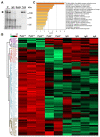
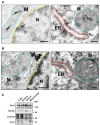

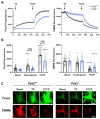
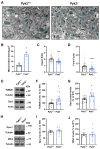

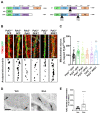
Similar articles
-
Pyk2 modulates hippocampal excitatory synapses and contributes to cognitive deficits in a Huntington's disease model.Nat Commun. 2017 May 30;8:15592. doi: 10.1038/ncomms15592. Nat Commun. 2017. PMID: 28555636 Free PMC article.
-
Calcineurin is essential for depolarization-induced nuclear translocation and tyrosine phosphorylation of PYK2 in neurons.J Cell Sci. 2007 Sep 1;120(Pt 17):3034-44. doi: 10.1242/jcs.009613. Epub 2007 Aug 7. J Cell Sci. 2007. PMID: 17684059
-
Adrenergic signaling regulates mitochondrial Ca2+ uptake through Pyk2-dependent tyrosine phosphorylation of the mitochondrial Ca2+ uniporter.Antioxid Redox Signal. 2014 Aug 20;21(6):863-79. doi: 10.1089/ars.2013.5394. Epub 2014 Jun 25. Antioxid Redox Signal. 2014. PMID: 24800979 Free PMC article.
-
Focal Adhesion Kinases in Platelet Function and Thrombosis.Arterioscler Thromb Vasc Biol. 2019 May;39(5):857-868. doi: 10.1161/ATVBAHA.118.311787. Arterioscler Thromb Vasc Biol. 2019. PMID: 30894012 Review.
-
Mitochondria Associated Membranes (MAMs): Architecture and physiopathological role.Cell Calcium. 2021 Mar;94:102343. doi: 10.1016/j.ceca.2020.102343. Epub 2021 Jan 2. Cell Calcium. 2021. PMID: 33418313 Review.
Cited by
-
Mitochondrial translation failure represses cholesterol gene expression via Pyk2-Gsk3β-Srebp2 axis.Life Sci Alliance. 2024 May 8;7(7):e202302423. doi: 10.26508/lsa.202302423. Print 2024 Jul. Life Sci Alliance. 2024. PMID: 38719751 Free PMC article.
-
Fyn Signaling in Ischemia-Reperfusion Injury: Potential and Therapeutic Implications.Mediators Inflamm. 2022 Sep 15;2022:9112127. doi: 10.1155/2022/9112127. eCollection 2022. Mediators Inflamm. 2022. PMID: 36157893 Free PMC article. Review.
-
Coupling of Alzheimer's Disease Genetic Risk Factors with Viral Susceptibility and Inflammation.Aging Dis. 2024 Oct 1;15(5):2028-2050. doi: 10.14336/AD.2023.1017. Aging Dis. 2024. PMID: 37962454 Free PMC article. Review.
-
The mitochondrial-endoplasmic reticulum co-transfer in dental pulp stromal cell promotes pulp injury repair.Cell Prolif. 2024 Jan;57(1):e13530. doi: 10.1111/cpr.13530. Epub 2023 Jul 26. Cell Prolif. 2024. PMID: 37493094 Free PMC article.
-
Research progress of PYK2 in digestive system diseases.Front Immunol. 2025 Jul 17;16:1614589. doi: 10.3389/fimmu.2025.1614589. eCollection 2025. Front Immunol. 2025. PMID: 40746536 Free PMC article. Review.
References
-
- Giralt A., Brito V., Chevy Q., Simonnet C., Otsu Y., Cifuentes-Díaz C., De Pins B., Coura R., Alberch J., Ginés S., et al. Pyk2 modulates hippocampal excitatory synapses and contributes to cognitive deficits in a Huntington’s disease model. Nat. Commun. 2017;8:15592. doi: 10.1038/ncomms15592. - DOI - PMC - PubMed
-
- Corvol J.-C., Valjent E., Toutant M., Enslen H., Irinopoulou T., Lev S., Hervé D., Girault J.-A. Depolarization Activates ERK and Proline-rich Tyrosine Kinase 2 (PYK2) Independently in Different Cellular Compartments in Hippocampal Slices. J. Biol. Chem. 2005;280:660–668. doi: 10.1074/jbc.M411312200. - DOI - PubMed
-
- Menegon A., Burgaya F., Baudot P., Dunlap D.D., Girault J.-A., Valtorta F. FAK + and PYK2/CAKβ, two related tyrosine kinases highly expressed in the central nervous system: Similarities and differences in the expression pattern. Eur. J. Neurosci. 1999;11:3777–3788. doi: 10.1046/j.1460-9568.1999.00798.x. - DOI - PubMed
-
- Faure C., Corvol J.-C., Toutant M., Valjent E., Hvalby O., Jensen V., El Messari S., Corsi J.-M., Kadare G., Girault J.-A. Calcineurin is essential for depolarization-induced nuclear translocation and tyrosine phosphorylation of PYK2 in neurons. J. Cell Sci. 2007;120:3034–3044. doi: 10.1242/jcs.009613. - DOI - PubMed
Publication types
MeSH terms
Substances
LinkOut - more resources
Full Text Sources
Miscellaneous

